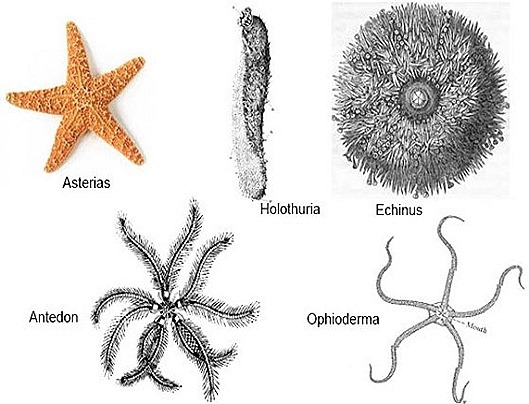ECHINODERMATA CHAHACTERS- CLASSIFICATION
ECHINODERMATA GENERAL CHARACTERS AND CLASSIFICATION
Echinodermata means spiny skinned animals. This name was first proposed by Jacob Kelin (1734) for echi-noids. It was Leuckert (1847) who first established Echinodermata as a distinct group of the animal kingdom.
1) They are exclusively marine.
2) They are free living. Some are pelagic. Some are creeping on the sea bottom.
3) These are all triploblastic and co-elomate animals.
4) Adults show pentaradial symmetry and larval form show bilateral symmetry.
5) The size varies from moderate to considerable size.
6) Shape of the body is spherical or globular or elongated. It shows oral aboral and sides.
7) Exo and endo skeletons will be present.
8) Endo-skeletoh is mesodermal. It is made by hard polygonal plants.
9) Body walls include only Epidermis, dermis and peritonium
10) Body cavity or coelome is large. It is an entero-coelome. It is lined by
ciliated peritonium.
11) Respiration is carried on by
a) Papullae-Star fish.
b) Peristomial gills - Sea urchin.
c) Genital bursae - Brittle star.
d) Respiratory trees - Holothurians.
12) Excretory organs are absent.
13) Nervous system is primitive. Brain is absent.
14) Special sense organs are poorly developed. Eye spots and statocysts are present.
15) Reproduction is sexual. Sexes are separate. Sexual dimorphism is absent. Gonads are iarge.
16) Gametes are iiberated into the water. Fertilisation is external.
17) Eggs are homolethial. Cleavage is radial and indeterminate type.
18) Life history includes larval stage.
19) They can show autotomy and regeneration.

Classification of Echinodermata:
The classification followed here is based on Hyman's Classification.
SUB PHYLUM I : PELMATOZOA : Mostly extinct echinoderms. Mouth and anal.aperture present on the oral surface. Tube feet are primarily food catching. They do not show suckers, pelmatozoa has only one living class.
Class : Crinoidia: Extinct and living forms. Living members are with stalk. Oral surface is directed upwards. Mouth is usually central. Anus is usually excentric. They are present on the oral surface. Arms movable, simple mostly branched, usually five or ten in number. Madreporite, spines and pedicellariae are present. Larva is doliolaria.
Order : Articulata : Mouth and ambulacra! grooves remain exposed.
Ex : Antedon, Metacrinus.
SUB PHYLUM D : ELEUTHEROZOA : Mostly living echinoderms. Stem or stalk is absent. They are living forms. Body structure is usually pentamerous. Oral surface has mouth. It is downwards. Anus usually on the aboral surface.
Class 1 : Holothuroidea : Body bilaterally symmetrical, usually elongated in the oral aboral axis having mouth at or near one end and anus or near the other end.
Order 1: Aspidochirota : A pair of well developed respiratory trees is present.
Ex: Holothuria.
Order 2 : Elaslpoda : Many tube feet. Mouth is usually ventral and surrounded by 10-20 branched tentacles: Ex: Elphidia.
Order 3 : Dendrochlrota : Tube feet are numerous. Oral tentacles are dendritic or branched like tree branches. Respiratory trees are present. Ex : Thyone, Cucumaria.
Order 4: Molpadonia : Tube feet are absent. Oral tentacles are digitate or finger shaped.
Ex : Molpadia.
Order 5: Apoda: Body vermiform having smooth or watry surface. Tube feet are absent. Oral tentacles are 10-20, simple, digitate or pinnate. Ex : Synapta.
Class 2 : Echinodea : Body is spherical, disc like, oval or heart shaped. Body is enclosed in an endoskeletal shell or test of closely fitted calcareous plates covered with movable spines. Ambulacral grooves are absent. Pedicellariae are stalked and three jawed. Sexes are separate. Larval form is echinopluteus larva.
Subclass 1: Regularla : Body is gbbular, mostly circular and sometimes oval in shape. Symmetry is pentamerous. Aristotle's lantern is well developed.
Order 1: Lepidocentroida :
Ex : Poormosoma.
Order 2 : Cidaroidea :
Ex : Cidaris, Notocidaris.
Order 3 r Auhdonta :
Ex.: Diodema, Astropyga.
Order 4 : Camarodonta ;
Ex : Echinus, Strongylocentrotus.

Subclass 2 : Irregularia : Test is mostly flattened oval to circular. Symmetry is bilateral. Mouth centrally placed on the oral surface. '
Order 1 : Clypeatrolda : Aristotle's lantern is present. Gills are absent. Ex : Clypeaster.'
Order 2 : Spatangoida : Test is oval or heart shaped, Gills absent. Ex : Lovenia, Echinocardium.
Class 3: Asteroidea : Body is flat, pentagonal or star shaped. Oral and aboral surfaces are distinct. Sexes separate, gonads radially arranged. Development includes bipinnaria or brachiolaria larva..
Order 1; Phanerozonia: Arms are provided with two rows of conspicuous marginal plates. Pedicellariae are alveolar or sessile type. Tube feet are arranged in two rows.
Ex : Astropecten.
Order 2: Spinulosa : Arms are generally without conspicuous marginal plates. Pedicellariae are rarely present. Ex : Astorina, Echinaster.
Order 3: Forcipulata : Podia or tube feet are arranged in four rows and provided with suckers. Papulae are on both surfaces. Mouth frame is of ambulacral type.
Ex: Asterias.
Clsss 4 : Ophiuroidea : Body is flattened with a pentamerous or rounded central disc. Oral and aboral surfaces are distinct. Arms usually five, rarely six or seven, are long and slender. Ambulacral grooves are absent. Madreporite is on the oral surface. Sexes are separate.
Order 1 : Ophiurae : Arms are simple, mostly five in number.
Ex : Ophioderma, Ophiothrix.
Order 2 : Euryalae ; Arms are simple or branched. Disc and arms are without or poorly developed. One madreporite in each inter radius. Ex : Astrophyton, Astroporpa.
